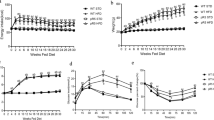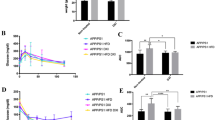Abstract
Objectives
Cases of sporadic Alzheimer’s disease (SAD) are the predominant form of the age-related dementia. New evidence suggests that metabolic syndrome (MS), a metabolic disorder, is an initiating factor of some SAD cases. A high-sugar high-fat diet could cause MS, we aimed to investigate whether it could directly lead to SAD.
Measurements
The characteristic molecules of AD (hippocampus Aβ and Tau) were tested by using ELISA and western blotting to confirm the happening hallmarks of AD in brain. MS and inflammation related biochemical indicators were measured using immunological method. Proteins associated with the insulin resistance signal pathway (JNK, PI-3K, AKT, GSK-3β, GLUT3) were evaluated using western blotting method. The levels of reactive oxygen species (ROS) were measured by immunofluorescence method.
Results
Expressions of hippocampus Aβ, phosphorylation-Tau (p-Tau), inflammatory factors and p-JNK, Gsk-3βwere higher in the model rats than those in the control rats and expressions of p-PI3K, p-AKT and GLUT3 were reversed.
Conclusions
The MS model animals, which can induce the characteristics symptoms of AD, and therefore it may be preliminarily considered that the AD pertains to the MS-related diseases.






Similar content being viewed by others
References
Rasgon N, Jarvik L. Insulin resistance, affective disorders, and Alzheimer’s disease: review and hypothesis. J Gerontol A Biol Sci Med Sci 2004;59:178–83.
Holscher C, Gengler S, Gault VA, Harriott P, Mallot HA. Soluble betaamyloid[ 25-35] reversibly impairs hippocampal synaptic plasticity and spatial learning. Eur J Pharmacol 2007;561:85–90.
Zetterberg H, Blennow K, Hanse E. Amyloid beta and APP as biomarkers for Alzheimer’s disease. Exp Gerontol 2010;45:23–29.
Cheng XJ, Gao Y, Zhao YW, et al. Sodium chloride increases Aβlevels by suppressing Aβclearance in cultured cells. PloS ONE 2015;10(6): e0130432. doi:10.1371/journal.
Monteiro R, Azevedo I. Chronic inflammation in obesity and the metabolic syndrome. Mediators Inflamm 2010. doi:10.1155/2010/289645.
Knight EM, Martins IV, Gümüsgöz S, Allan SM, Lawrence CB. High-fat dietinduced memory impairment in triple-transgenic Alzheimer’s disease (3xTgAD) mice is independent of changes in amyloid and tau pathology. Neurobiol Aging 2014;35:1821–32.
Morris MC, Tangney CC. Dietary fat composition and dementia risk. Neurobiol Aging 2014;35S2:S59–64.
Bernard ND, Bush AI, Ceccarelli A, Cooper J, de Jager CA, Erickson KI, Fraser G, Kesler S, Levin SM, Lucey B, Morris MC, Squitti R. Dietary and lifestyle guidelines for the prevention of Alzheimer’s disease. Neurobiol Aging 2014;35S2:S74–8.
Vanhanen M, Koivisto K, Moilanen L,et al. Association of metabolic syndrome with Alzheimer disease: a population-based study. Neurology 2006;67:843–7.
Craft S. Insulin resistance and Alzheimer’s disease pathogenesis: potential mechanisms and implications for treatment. Curr Alzheimer Res 2007;4:147–152.
Han B, Wu F, Zhao N, et al. Study on intestinal endototemia in patients with Alzheimer’s disease. Chech Psychiafie.2012;Supp1:187.
Talbot K, Wang H-Y, Kazi H, Han L-Y, Bakshi KP, Stucky A, Fuino RL, Kawaguchi KR, Samoyedny AJ, Wilson RS. Demonstrated brain insulin resistance in Alzheimer’s disease patients is associated with IGF-1 resistance, IRS-1 dysregulation, and cognitive decline. J Clin Investig 2012;122:1316.
Cai HY, Holscher C, Yue XH, Zhang SX, Wang XH, Qiao F, Yang W, Qi JS. Lixisenatide rescues spatial memory and synaptic plasticity from amyloid proteininduced impairments in rats. Neuroscience 2014;2776–13.
Zhou X, Han D, Xu R, Li S, Wu H, et al. A model of metabolic syndrome and related diseases with intestinal endotoxemia in rats fed a high fat and high sucrose diet. PloS ONE 2014;9(12): e115148. doi:10.1371/journal.
DeFronzo RA. Dysfunctional fat cells, lipotoxicity and type 2 diabetes. Int J Clin Pract Suppl 2004;143:9–21.
Harte AL, da Silva NF, Creely SJ, et al. Elevated endotoxin levels in non-alcoholic fattyliver disease. Journal of Inflammation 2010;7(15):1–10.
Mehta NN, McGillicuddy FC, Anderson PD, et al. Experimental endotoxemia induces adipose inflammation and insulin resistance in humans. Diabetes 2010;59:172–81.
Wu HW, Ren LF, Zhou X, Han DW. A high-fructose diet induces hippocampal insulin resistance and exacerbates memory deficits in male Sprague-Dawley rats. Nutr Neurosci 2014. [Epub ahead of print]
Nanes MS. Tumor necrosis factor-[alpha]: molecular and cellular mechanisms in skeletal pathology. Gene 2003;321:1–15.
Catrina Sims-Robinson, Bhumsoo Kim, Andrew Rosko, Eva L. Feldman. How does diabetes accelerate Alzheimer disease pathology? Nat Rev Neurol. 2010;6(10): 551–559.
Xiaobin Tan, Junfei Gu, Bingjie Zhao, Shuyuan Wang, Jiarui Yuan. Ginseng improves cognitive deficit via the RAGE/NF-kB pathway in advanced glycation end product-induced rats. Ginseng Res 2015;39:116–124.
Bo-Ryoung Choi, Woo-Hyun Cho, Jiyoung Kim, Hyong Joo Lee, ChiHye Chung et al. Increased expression of the receptor for advanced glycation end products in neurons and astrocytes in a triple transgenic mouse model of Alzheimer’s disease. Experimental & Molecular Medicine 2014;46:e75.
Zhang YY, Fan YC, Wang M, Wang D, Li XH. Atorvastatin attenuates the production of IL-1beta, IL-6, and TNF-alpha in the hippocampus of an amyloid beta1-42-induced rat model of Alzheimer’s disease. Clin Interv Aging 2013;8:103–10.
Takeda S, Sato N, Ikimura K, et al. Increased blood-brain barrier vulnerability to systemic inflammation in an Alzheimer disease mouse model. Neurobiol Aging 2013;3:2064–70.
Tamagno E, Parola M, Bardini P, et al. Beta-site APP cleaving enzyme up-regulation induced by 4-hydroxynonenal is mediated by stress-activated protein kinases pathways. J Neurochem 2005;92:628–36.
Sabio G, Kennedy NJ, Cavanagh-Kyros J, et al. Role of muscle c-Jun NH2-terminal kinase 1 in obesity-induced insulin resistance. Mol Cell Biol 2010;30:106–15.
Solinas G, Vilcu C, Neels JG, et al. JNK1 in hematopoietically derived cells contributes to diet-induced inflammation and insulin resistance without affecting obesity. Cell Metab 2007;6:386–97.
Ma R, Xiong N, Huang C, et al. Erythropoietin protects PC12 cells from betaamyloid( 25-35)-induced apoptosis via PI3K/Akt signaling pathway. Neuropharmocology 2009;56:1027–34.
Winnay JN, Boucher J, Mori MA, Ueki K, Kahn CR. A regulatory subunit of phosphoinositide 3-kinase increases the nuclear accumulation of X-box-binding protein-1 to modulate the unfolded protein response. Nat Med 2010;16:438–45.
Schulingkamp RJ, Pagano TC, Hung D, et al. Insulin receptors and insulin action in the brain: review and clinical implications. Neurosci Biobehav Rev 2010;24:855–72.
Semeels L, Van Biervliet J, Craessaerts K, et al. Gamma-Secretase heterogeneity in the Aphl subunit: relevance for Alzheimer’s disease. Science 2009;324:639–42.
Elrod JW, Molkentin JD. Physiologic functions of cyclophilin D and the mitochondrial permeability transition pore. Circ 2013;J77:1111–22.
Chi LY, Wang SJ, Li XG. Poly(ADP-ribose) signal in seizures-induced neuron death. Med Hypotheses 2008;71:283–5.
Meigs JB, Larson MG, Fox CS, Keaney JF Jr, Vasan RS, Benjamin EJ. Association of oxidative stress, insulin resistance, and diabetes risk phenotypes: the Framingham Offspring Study. Diabetes Care 2007;30:2529–35.
Tirosh A, Potashnik R, Bashan N, et al. Oxidative stress disrupts insulin-induced cellular redistribution of insulin receptor substrate-1 and phosphatidylinositol 3-kinase in 3T3-L1adipocytes. J Biol Chem 2009;274:10595–602.
Author information
Authors and Affiliations
Corresponding author
Rights and permissions
About this article
Cite this article
Niu, L., Han, D., Xu, R.L. et al. A high-sugar high-fat diet induced metabolic syndrome shows some symptoms of Alzheimer’s disease in rats. J Nutr Health Aging 20, 509–513 (2016). https://doi.org/10.1007/s12603-015-0601-1
Received:
Accepted:
Published:
Issue Date:
DOI: https://doi.org/10.1007/s12603-015-0601-1




